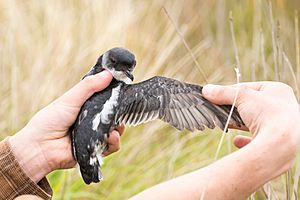Whenua Hou diving petrel facts for kids
Quick facts for kids Whenua Hou diving petrel |
|
|---|---|
 |
|
| Conservation status | |
| Scientific classification | |
| Genus: |
Pelecanoides
|
| Species: |
whenuahouensis
|
The Whenua Hou diving-petrel (Pelecanoides whenuahouensis) is a very rare diving petrel bird found only in New Zealand. It was first officially named and described by scientists in 2018. Before that, people thought it was just a special group of the South Georgia diving petrel. But now, we know it's a different species because it likes different places to live and has unique features.
Today, there are fewer than 150 of these birds left. They live and breed only on Whenua Hou island, which is a safe place without predators. Unlike other diving petrels, the Whenua Hou diving-petrel builds its nests by digging burrows in the sand dunes near Sealers Bay. Other diving petrels usually nest on rocky hills or flat ground.
Where Do They Live?
The Whenua Hou diving-petrel is a special bird that lives only in New Zealand. Its main home is a small island called Whenua Hou. This island is a safe haven for them because it does not have animals that hunt birds.
Scientists have found old bird bones, called subfossils, that show these petrels used to live on other islands too. They once lived on Auckland Island and Stewart Island. It is also possible they lived on the Chatham and Macquarie islands a long time ago.
Why Are They Endangered?
The Whenua Hou diving-petrel is in great danger. Many things threaten this small bird population.
Past Dangers
In the past, these birds disappeared from some islands.
- On Auckland Island, New Zealand sea lions destroyed their nests.
- On Stewart Island, rats called Polynesian rats hunted the birds and ate their eggs. These rats were brought to the island by people.
Current Dangers
Even on Whenua Hou, the birds face many threats:
- Storms: Big storms can cause the sand dunes where they nest to collapse. For example, a storm in 2003 destroyed many nests and killed many birds.
- Plants: Some plants, like coastal forests and invasive grasses, are growing over the sand dunes. This makes it harder for the petrels to dig their nests.
- Rising Sea Levels: Because of climate change, the sea level is slowly rising. This can flood the nesting areas on the dunes.
- Oil Spills: We do not know exactly where these petrels find their food in the ocean. If there was an oil spill in their feeding areas, it would be very bad for the whole species.
Scientists and conservation groups are working hard to protect the Whenua Hou diving-petrel and help its population grow.


